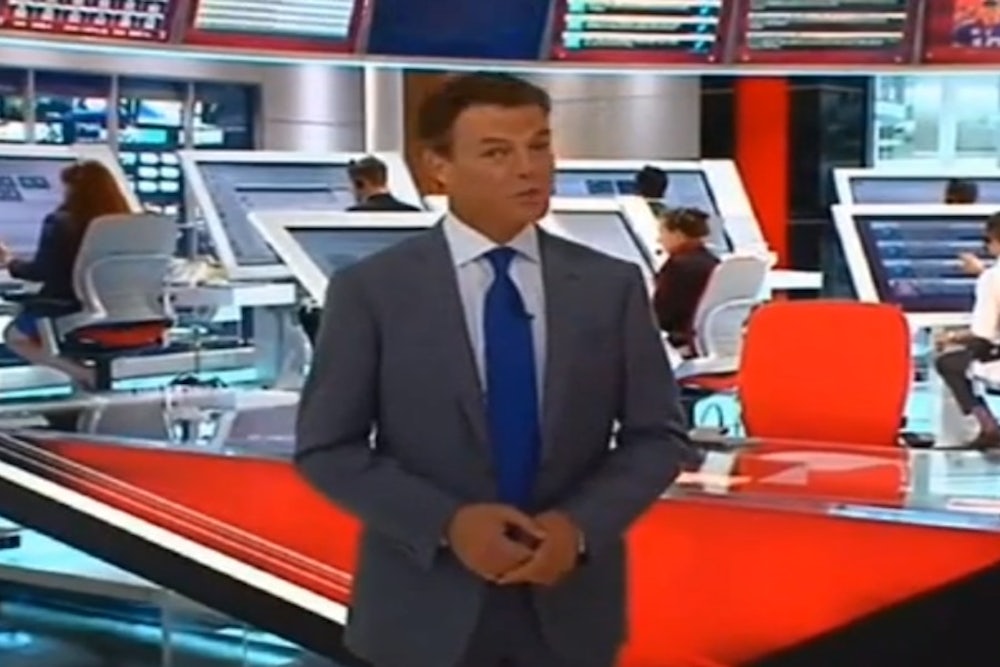This week, Fox News' Shepard Smith debuted the network's new newsroom set, featuring giant, 55-inch table screens that the Verge said "could be mistaken for a College Humor or Saturday Night Live parody." Who wants to scroll Twitter on a screen bigger than their bodies, as the Fox journalists are shown to be doing in the background of the set?
While the Fox set might merely look like a ridiculous bit of futurism—and, to be clear, it is—it also marries two longtime trends in television news sets. Television news started out, more or less, as radio on camera.
But since the 1960s, the medium has sought to differentiate itself visually in two ways, according to NYU Professor of Journalism Mitchell Stephens. TV news sets have generally strived to look either cutting edge or like real newsrooms, where people actually work. (On shows like "Morning Joe," you'll see the cameras in some shots, and TVs showing other news that presumably the producers are monitoring.) The new Fox set tries to be both functional and futuristic. It's an interesting contrast to newspapers' designs which, says Stephens, have always looked to the past rather than the future. Even when the New York Times' iconic logo debuted, the script was relatively old-fashioned looking.
When a young Peter Jennings briefly took over the ABC News broadcast in 1965, the new set had the kind of sleek, spare furniture that had not yet become commonplace in American homes, and a desk set that looks somewhat space age.
As the century progressed, technology, not design, became the way to signal forward-thinking. The space vibe stuck around for a while, though. An early CNN election night set, which featured televisions in the background of the shot, looks as if it could have been repurposed from a Star Wars set and shot inside the Millenium Falcon. CNN, which was of course meant to be an entirely new and all-encompassing kind of television news, has always skewed futuristic. In early years, this meant employing the news crawl. The debuts of the green screen and HD technology have also been meaningful to the way the television news medium actually works. More recently, the technology has grown more and more baroque and less immediately pragmatic. There was John King's touch-screen election map, a thermometer that showed the studio audience's instantaneous feelings about each candidate during debates, and Wolf Blitzer's embarassing election night use of hologram interviews. (Perhaps someone at CNN just has a real thing for Star Wars.)
CNN wasn't alone in that futurism —nor is the current Fox set the most ridiculous use of technology. In the 1980s, a syndicated program, George Michael Sports Machine, created turned the set into a faux-magic-computer (the titular "sports machine") that spat out the highlights. It was a metaphor for television, enacted on television. TV was the future then.
There are, of course, sets that remain simpler and more clearly descended from the Edward Murrow one. PBS' News Hour, for instance, is about as spare as they come, but Georgetown Assistant Professor of Communications, Culture, and Technology Kimberly Meltzer says that the design has been shown to drive away some viewers. Maybe Fox's huge touchscreens aren't just signaling futurism, she adds. "It did occur to me that they're trying to appear more transparent to viewers by showing us what they themselves are looking at and using," says Meltzer. Fox isn't alone in seeking this out lately. The Today Show has lately added the "Orange Room" with Carson Daly, featuring large screens displaying tweets in the background. The future isn't space travel any more, or even television; it's online, and that's a bit harder to show visually in a compelling way onscreen.
Or, my pet theory about the new giant tablets, it's simply demographics: Fox, whose audience (like PBS') skews older, has always gone for flash—on set designs, sure, but also when it comes to the hair and makeup worn by female anchors, which one makeup artist speculated to the Atlantic's Liza Mundy caters to the tastes of older men. Those Barry Bonds-sized, jacked-up tablets look, to me, like what an old person's hope for the future might be: big, bright, and easy to see without reading glasses.
Noreen Malone is a staff writer at the New Republic.
